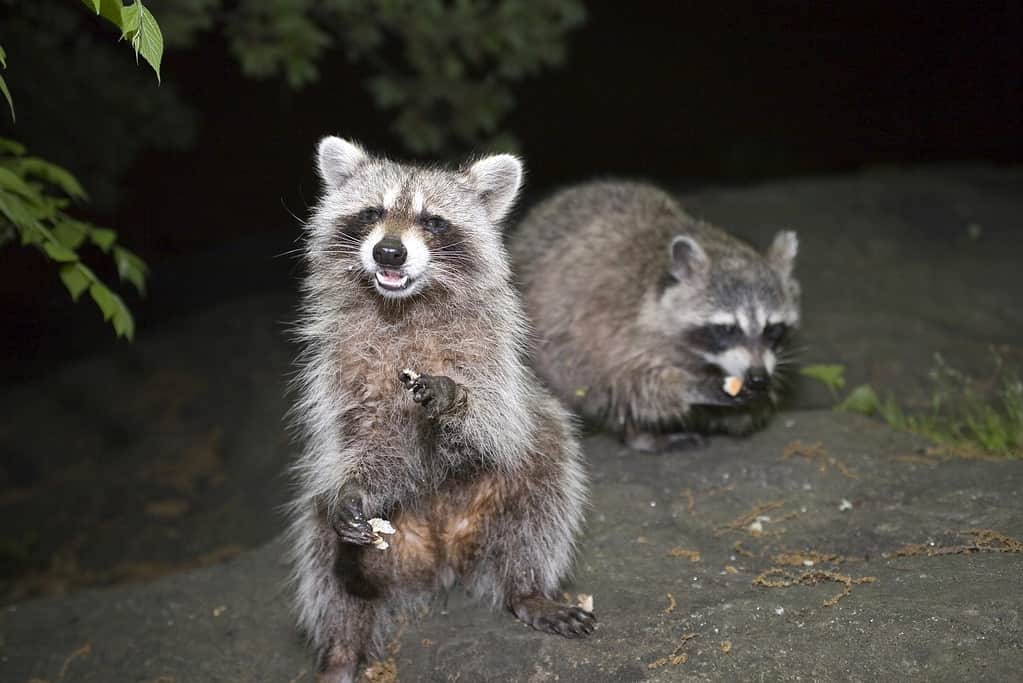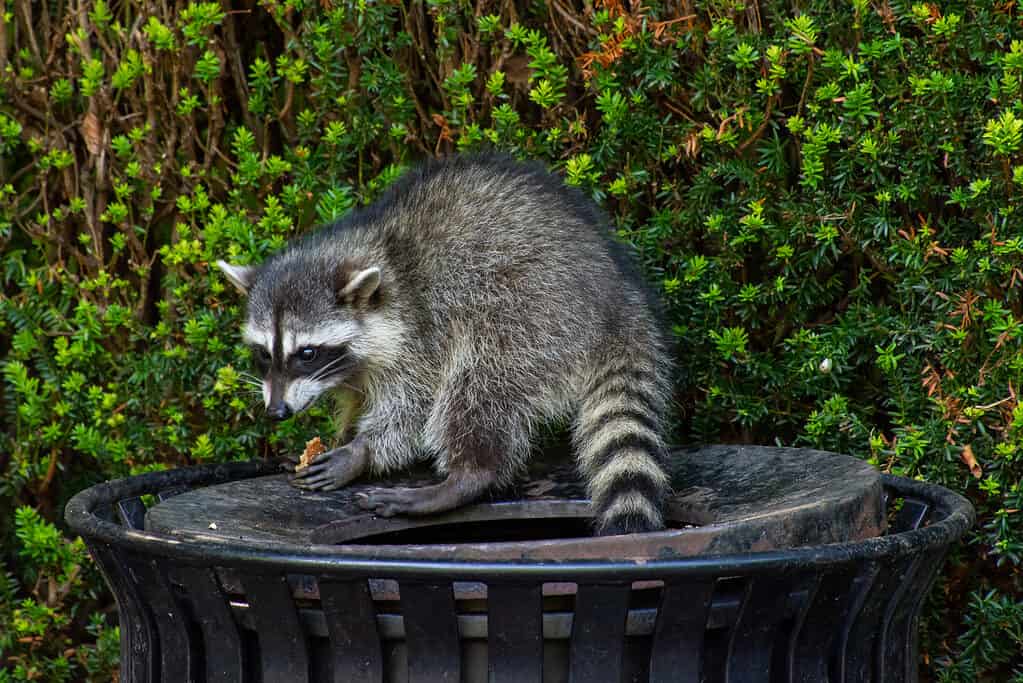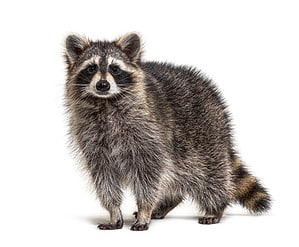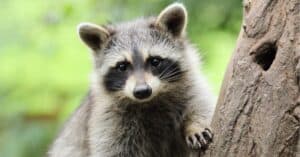They’re your backyard bandits — more interested in your garbage than what’s in your safe. While what you throw out may be a treasure for them, they sure do know how to make a mess, leaving evidence strewn across your yard and driveway. But how do you keep them from getting into your trash? Discover the 10 most effective ways to raccoon-proof your trash cans!
Raccoon Overview
Raccoons are medium-sized mammals that have a distinctive appearance. Not only can you easily recognize them by their ringed tails, but you can also easily spot them by looking at their faces. The fur around their eyes makes it look like they’re wearing a mask, and their coats are a grayish-brown color. These animals are native to North America and don’t just live in forested environments. They are quite comfortable in urban neighborhoods as well, where they have plenty of trash cans to pick through to find some snacks.
It’s unlikely for you to see them during the day because they are nocturnal. They emerge at night to scavenge either in your neighborhood or at your local park. They can be quite cute if you have an appreciation for medium-sized mammals, but they can also be dangerous. Raccoons can carry a range of diseases, including rabies. This is why you should steer clear if you happen to spot one near your home. It’s also best to train your pets to avoid contact with them as well.

Raccoons are nocturnal and opportunistic, feeding on whatever they can find.
©iStock.com/eddtoro
Raccoon Behavior
How raccoons behave depends on where they’re living, what season it is, and how old they are. These wild animals are solitary by nature, omnivorous, and surprisingly clever. Below, we break down raccoon behavior.
Solitary Behavior
While some animals in the wild are social, forming large social groups, this is not the case for raccoons. Generally, they operate on their own. They might share a specific territory with other raccoons, but they don’t rely on each other in the way that some animals do. The only time that there is an exception to this rule is when a mother raccoon has her kits with her. At this stage, she still cares for them, so they stick together as a family during that phase.
Seasonal Behavior
The way raccoons behave changes depending on the seasons. For example, during the spring in the summer, the female raccoons are focused on their litters. During these seasons, they are actively foraging for food and making sure that they can keep their kits well-fed and safe. You’re more likely to spot a raccoon during the day during these seasons. However, when fall and winter roll around, raccoons settle into their nocturnal schedule. During the colder months, food is scarcer, so they do their best to prepare and store food so that they have sustenance during the months when the climate is harshest.
Nocturnal Behavior
Aside from female raccoons in the spring and summer venturing out during the day to find food for their kids, raccoons are mostly active once night falls. They are well adapted to navigate low light conditions. Their night vision is impressive! This allows them to avoid any potential predators and access the food sources they’re interested in (like those scraps inside your trash cans!).
Vocalizations
Since you typically don’t see raccoons during the day, you may not even realize that they use a range of vocalizations to communicate. Sometimes they emit a low growl, sometimes they chatter and chirp, and sometimes they hiss. This is how they communicate with one another to either signal that something is going wrong or to let another raccoon know that they’re encroaching on an established territory.
Home Range and Dens
A raccoon’s territory is basically its home range. Within the home range, there are several different denning sites where they seek shelter. These dens aren’t just for shelter from the weather or predators, they’re also vital for kits and mother raccoons since this is where they rear their young.

Raccoons create dens in tree hollows, rock crevices, and burrows dug by other animals.
©Georgi Baird/Shutterstock.com
Problem-Solving Behavior
Raccoons are highly intelligent creatures. Their ability to problem solve might leave you with your mouth open. Their front paws can grab, which allows them to manipulate a range of different objects, including outdoor trash bins. Even a closed trashcan is susceptible to getting raided by a clever raccoon. They can remove lids and open doors. This is what makes them so great as scavengers! They are unbelievably resourceful when it comes to finding food for themselves and their kits.
What Do Racoons Eat?
Raccoons are omnivores, meaning they eat meat and plants. Their diet encompasses a wide variety of food sources. For example, if fruits and vegetables are available, they are going to feast. This can be your garden crops, apples growing on trees or that have fallen from trees, and any other items they might find in a park or in a yard. If they know that you have a garden that has vegetables and fruit, they get creative in finding ways to raid it.
Raccoons also snack on insects. It could be anything from a grasshopper to a worm. They know where to find them, too. Raccoons know to use their little grubby hands to turn over rocks so that they can uncover the insects that are living beneath them. They don’t stop at insects. They also eat small animals like birds and rodents. Raccoons are mighty skilled when it comes to hunting and they may even get into water to catch fish! When they enter water, it’s not just the fish they go for. They may also snack on mollusks and crabs.
Being that raccoons are opportunistic, they don’t just eat birds, they also eat bird eggs. Although this serves as sustenance for the raccoons, it severely impacts the bird population in the area when they do this. Their meaty meals don’t need to be alive when they find them. Raccoons eat carrion indiscriminately. Considering that a raccoon eats rotting flesh, there’s nothing in your trash that can turn them off.
They eat human food looking for scraps and if you have a compost bin, they’ll get into that too. Aside from fruits, vegetables, and meat, they also eat nuts. During the fall season, they have access to options like walnuts and acorns, so they take advantage of that abundance. When food sources are scarce, they seek out plants to keep their bellies full.
The 10 Most Effective Ways to Raccoon-Proof Your Trash Cans
1. Understand the Little Bandits
Know that raccoons are opportunistic scavengers. There’s almost nothing they won’t try at least once. Their hands are equipped with dexterous fingers, meaning they can remove lids and unlatch doors. They are clever and they have a rather large home range.
Shooing them away from your property doesn’t mean they’re going to starve. They can weigh anywhere between seven and 20 pounds, which means you might have little ones and you might have some fatter raccoons in your area. If you leave food in trash bins they can access, you can expect that they’ll raid them for scraps.

Raccoons aren’t picky and snack opportunistically on food scraps.
©kingma photos/Shutterstock.com
2. Lock Down Those Bins
If you leave your trash bins outside and they don’t have a lid you can secure, raccoons are going to get to them. Either lock them down if you have to keep them outside or keep them inside your garage, storage, or shed to make sure that any raccoons in the area can’t access them.
3. Get to Cleaning!
Take a look around your trash bins. Could it use a little sprucing up? If there are pieces of trash or even food particles lingering around your trashcan, as small as they are, they’re going to attract raccoons. Pick a day and get to cleaning that trash area so that it’s pristine. Sometimes, the use of bleach can help to deter raccoons as well. This doesn’t always work with these little rascals but it’s worth a shot.
4. Pay Mind to Your Yard
Similarly, consider your entire yard both in the back of your property and in the front. Raccoons like to stick around areas where they can get cozy. If you have untrimmed shrubs or piles of leaves in your yard, tend to them. Create a minimalist type of yard without lots of debris so that raccoons don’t think it’s an invitation for them to settle in and get comfortable.
5. Employ the Use of Repellants
You can create your own natural repellent to use around your trash bins at home. Some of the scents that raccoons are repelled by include garlic, onion, hot peppers, and peppermint oil. You can even use Epsom salt! Just mix it with water in a spray bottle and soak the area around your trash bins. This can help to deter them when they get close.
6. Bring in the Heavy-Duty Bins
If you can’t store your trash bins in the garage or shed, it’s worth investing in some heavy-duty trash bins. Something that you can lock and secure and that can keep even clever raccoons away is worth the expense. If you try out other options and you still have a problem, look at more secure trash bins to cut off the food supply for raccoons in your area.
7. Try a Fence
Another investment you can try is a fence. Either go all in and fence your entire property or just build a small enclosure specifically for your trash bins. This can keep them secure. It delivers a message to the raccoons that there is no longer easy access to your scraps.
8. Lock Down Food Sources
If you’re looking for a much more affordable solution that can work with your existing trash can, you might try a bin strap. This is a strap that you use on most garbage bins to secure the lid. It can become a bit of a bother if you are frequently going out to take out the trash because you have to secure the bin strap each time, but it does keep raccoons out!
9. Use Ammonia
Another cost-effective method you can try is spraying a little bit of ammonia onto every single trash bag you take out to your trash bin. This is a great repellent that you can use to keep raccoons away. Just don’t forget that each time you head out to your trash bin, you need to sprinkle a bit of that ammonia on there so they can pick up on the scent and go find a new food source.
10. Let There Be Light!
Raccoons love the cover of nightfall because they navigate well even when there isn’t a lot of light. It means they can be sneaky. But if you set up a light shining directly over your trash bins, they’re less likely to approach. Lights act as a deterrent. Raccoons don’t want to be found. They like to work in the darkness and quiet of night. So, make it look like daylight, instead!
The photo featured at the top of this post is © Jillian Cain Photography/Shutterstock.com
Thank you for reading! Have some feedback for us? Contact the AZ Animals editorial team.






